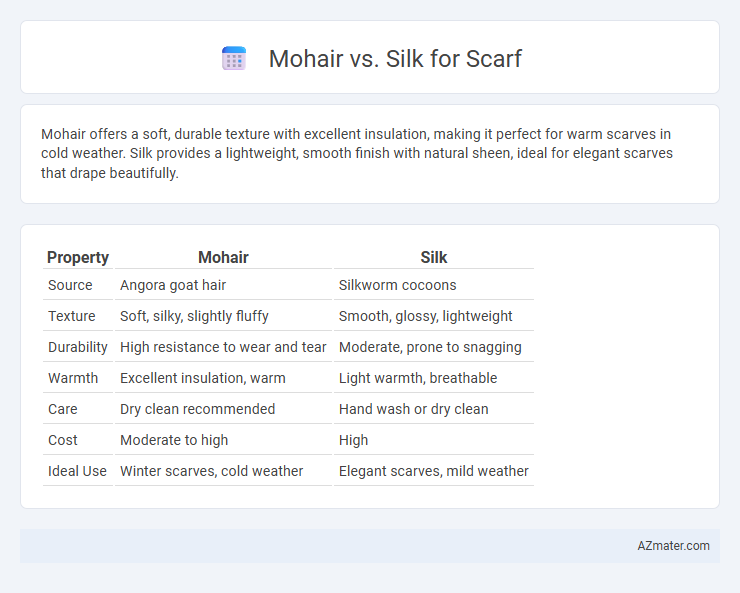Mohair offers a soft, durable texture with excellent insulation, making it perfect for warm scarves in cold weather. Silk provides a lightweight, smooth finish with natural sheen, ideal for elegant scarves that drape beautifully.
Table of Comparison
| Property | Mohair | Silk |
|---|---|---|
| Source | Angora goat hair | Silkworm cocoons |
| Texture | Soft, silky, slightly fluffy | Smooth, glossy, lightweight |
| Durability | High resistance to wear and tear | Moderate, prone to snagging |
| Warmth | Excellent insulation, warm | Light warmth, breathable |
| Care | Dry clean recommended | Hand wash or dry clean |
| Cost | Moderate to high | High |
| Ideal Use | Winter scarves, cold weather | Elegant scarves, mild weather |
Introduction to Mohair and Silk Scarves
Mohair scarves, crafted from the luxurious fibers of the Angora goat, offer exceptional warmth, softness, and durability, making them ideal for cold weather. Silk scarves, made from fine silkworm cocoons, provide a lightweight, smooth texture with a natural sheen that enhances elegance and breathability. Both materials cater to distinct style preferences and functional needs, balancing luxury with comfort.
Origin and Production of Mohair and Silk
Mohair is derived from the Angora goat, primarily raised in South Africa and Turkey, where the long, lustrous fibers are carefully sheared biannually to produce soft, durable yarn. Silk originates from the mulberry silkworms native to China, undergoing a labor-intensive process of cocoon harvesting and filament extraction to yield a smooth, natural fiber prized for its sheen. Both fibers undergo specialized cultivation and production methods reflective of their distinct animal sources and geographical origins, influencing their texture and quality in scarf manufacturing.
Texture and Feel: Mohair vs Silk
Mohair scarves exhibit a soft, fluffy texture with a slightly fuzzy surface, providing a warm and cozy feel ideal for colder seasons. Silk scarves feature a smooth, lustrous texture that glides gently against the skin, offering a lightweight and breathable sensation perfect for year-round wear. The contrast between mohair's insulating fluffiness and silk's sleek softness defines their unique tactile experiences.
Warmth and Breathability Comparison
Mohair scarves excel in warmth due to their high insulation properties, trapping heat effectively without feeling heavy. Silk scarves provide superior breathability, allowing air circulation that helps regulate temperature and prevent overheating. Choosing between mohair and silk depends on prioritizing either maximum warmth or lightweight, breathable comfort.
Durability and Longevity Differences
Mohair scarves offer superior durability due to their strong, resilient fibers derived from the Angora goat, making them resistant to wear and pilling over time. Silk scarves, while luxurious and smooth, tend to be more delicate and prone to snags and fraying, requiring careful handling for longevity. Choosing mohair ensures a longer-lasting scarf with excellent shape retention, whereas silk provides elegance but demands more maintenance to preserve its lifespan.
Style and Aesthetic Appeal
Mohair scarves boast a luxurious texture with a natural sheen that adds volume and softness, enhancing a cozy yet sophisticated look. Silk scarves offer a smooth, glossy finish that drapes elegantly, providing a refined and timeless aesthetic suitable for both casual and formal wear. Choosing between mohair and silk depends on whether the desired style emphasizes warmth and texture or sleekness and fluidity.
Allergies and Skin Sensitivity
Mohair scarves, made from Angora goat fibers, tend to be softer but can cause irritation in individuals with sensitive skin due to their fine, yet coarse texture. Silk scarves, derived from silkworm cocoons, are hypoallergenic and gentle, making them ideal for people prone to allergies or skin sensitivities. Choosing silk is generally better for those seeking a scarf that minimizes the risk of rashes, itching, or allergic reactions.
Care and Maintenance Requirements
Mohair scarves require gentle hand washing with cool water and mild detergent to preserve their softness and avoid felting, while silk scarves need delicate handling with cold water and a gentle silk-specific cleanser to maintain their sheen and prevent fabric weakening. Both fibers benefit from air drying flat away from direct sunlight to retain shape and color vibrancy. Storing scarves in breathable cotton bags protects mohair and silk from moisture and moth damage, ensuring longevity and luxurious texture.
Price Points and Value for Money
Mohair scarves typically range from $50 to $200, offering excellent warmth and durability with a soft texture, making them a cost-effective choice for long-term use. Silk scarves, priced between $30 and $300, provide a lightweight, luxurious feel and elegant sheen that justify higher prices depending on brand and craftsmanship. Evaluating value for money depends on the desired balance between mohair's insulation properties and silk's smoothness and style.
Best Uses: Choosing Between Mohair and Silk Scarves
Mohair scarves excel in providing warmth and a soft, fluffy texture, making them ideal for cold weather and casual, cozy outfits. Silk scarves offer a smooth, lightweight feel with natural sheen, perfect for elegant events and layering in mild climates. Selecting between mohair and silk depends on the desired warmth, texture, and occasion, with mohair favored for insulation and silk preferred for sophistication and breathability.

Infographic: Mohair vs Silk for Scarf
 azmater.com
azmater.com